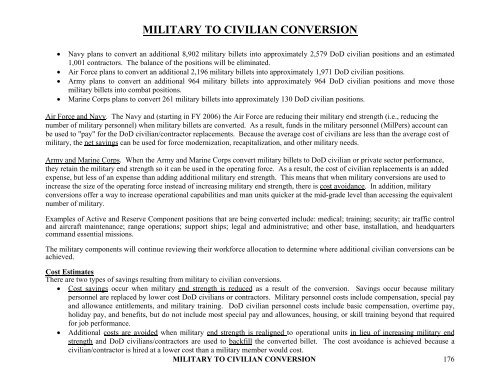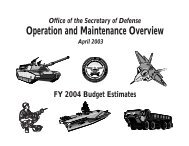- Page 1:
Office of the Secretary of Defense
- Page 4 and 5:
APPENDIX M-1, M-1A/O-1, O-1A Exhibi
- Page 6 and 7:
OPERATION AND MAINTENANCE TITLE SUM
- Page 8 and 9:
OPERATION AND MAINTENANCE TITLE SUM
- Page 10 and 11:
ARMY ($ in Millions) FY 2006 Price
- Page 12 and 13:
ARMY Budget Activity 1: Operating F
- Page 14 and 15:
ARMY Program, watercraft overhauls
- Page 16 and 17:
ARMY • Funding responsibility for
- Page 18 and 19:
ARMY North Atlantic Treaty Organiz
- Page 20 and 21:
NAVY FY 2006 1/ Price Program ($ in
- Page 22 and 23:
NAVY o Reduction of $18.1 million r
- Page 24 and 25:
NAVY o Additional funding of $15.0
- Page 26 and 27:
NAVY Budget Activity 2: Mobilizatio
- Page 28 and 29:
NAVY Budget Activity 4: Administrat
- Page 30 and 31:
MARINE CORPS FY 2006 Price Program
- Page 32 and 33:
MARINE CORPS increase of $+24.0 mil
- Page 34 and 35:
FY 2006 Actual * Price Change Progr
- Page 36 and 37:
AIR FORCE Specific program highligh
- Page 38 and 39:
FY 2006 Actual AIR FORCE Budget Act
- Page 40 and 41:
OPERATION AND MAINTENANCE, DEFENSE-
- Page 42 and 43:
RESERVE FORCES ($ in Millions) TOTA
- Page 44 and 45:
RESERVE FORCES NAVY RESERVE Program
- Page 46 and 47:
RESERVE FORCES AIR FORCE RESERVE Pr
- Page 48 and 49:
RESERVE FORCES AIR NATIONAL GUARD P
- Page 50 and 51:
DEFENSE HEALTH PROGRAM ($ in Millio
- Page 52 and 53:
DEFENSE HEALTH PROGRAM • $100.0 m
- Page 54 and 55:
DEFENSE HEALTH PROGRAM RDT&E Progra
- Page 56 and 57:
DRUG INTERDICTION AND COUNTERDRUG A
- Page 58 and 59:
DRUG INTERDICTION AND COUNTERDRUG A
- Page 60 and 61:
ENVIRONMENTAL RESTORATION TRANSFER
- Page 62 and 63:
FORMER SOVIET UNION THREAT REDUCTIO
- Page 64 and 65:
OVERSEAS CONTINGENCY OPERATIONS TRA
- Page 66 and 67:
OVERSEAS HUMANITARIAN DISASTER AND
- Page 68 and 69:
SUPPORT FOR INTERNATIONAL SPORTING
- Page 70 and 71:
AIR OPERATIONS ACTIVE ARMY The Army
- Page 72 and 73:
AIR OPERATIONS ARMY RESERVE The Arm
- Page 74 and 75:
AIR OPERATIONS The FY 2008 budget r
- Page 76 and 77:
AIR OPERATIONS Aircraft Depot Opera
- Page 78 and 79:
Funding Summary AIR OPERATIONS FY 2
- Page 80 and 81:
AIR OPERATIONS Primary Combat Force
- Page 82 and 83:
AIR OPERATIONS space systems and ai
- Page 84 and 85:
AIR OPERATIONS Primary Combat Force
- Page 86 and 87:
AIR OPERATIONS Primary Combat Force
- Page 88 and 89:
BASE OPERATIONS SUPPORT BOS FY 2006
- Page 90 and 91:
BASE OPERATIONS SUPPORT The Army’
- Page 92 and 93:
BASE OPERATIONS SUPPORT • Increas
- Page 94 and 95:
COMMAND, CONTROL, AND COMMUNICATION
- Page 96 and 97:
COMMAND, CONTROL, AND COMMUNICATION
- Page 98 and 99:
COMMAND, CONTROL, AND COMMUNICATION
- Page 100 and 101:
Department of Army: DEPOT MAINTENAN
- Page 102 and 103:
Department of Air Force: DEPOT MAIN
- Page 104 and 105:
DEPOT MAINTENANCE Funded Unfunded F
- Page 106 and 107:
ENVIRONMENTAL PROGRAMS health and s
- Page 108 and 109:
ENVIRONMENTAL PROGRAMS Base Realign
- Page 110 and 111:
ENVIRONMENTAL PROGRAMS ($ in Millio
- Page 112 and 113:
ENVIRONMENTAL PROGRAMS ($ in Millio
- Page 114 and 115:
Army Navy FACILITIES SUSTAINMENT, R
- Page 116 and 117:
Army 3,515.3 Marine Corps 2,536.8 T
- Page 118 and 119:
MARINE CORPS LAND FORCES The Operat
- Page 120 and 121:
LAND FORCES Body Armor Body Armor f
- Page 122 and 123:
Funding Summary: LAND FORCES Requir
- Page 124 and 125:
Afloat Prepositioned Fleet (APF) MO
- Page 126 and 127:
MOBILIZATION Other Mobilization Pro
- Page 128 and 129:
MOBILIZATION • Coast Guard: The i
- Page 130 and 131: PRISONER OF WAR/MISSING PERSONNEL A
- Page 132 and 133: RECRUITING, ADVERTISING, AND EXAMIN
- Page 134 and 135: RECRUITING, ADVERTISING, AND EXAMIN
- Page 136 and 137: Program Data SHIP OPERATIONS The FY
- Page 138 and 139: SHIP OPERATIONS FY 2006 Actual Chan
- Page 140 and 141: UNITED STATES SPECIAL OPERATIONS CO
- Page 142 and 143: UNITED STATES SPECIAL OPERATIONS CO
- Page 144 and 145: TRAINING AND EDUCATION FY 2006 Pric
- Page 146 and 147: TRAINING AND EDUCATION ($ in millio
- Page 148 and 149: TRAINING AND EDUCATION (Student/Tra
- Page 150 and 151: First Destination Transportation TR
- Page 152 and 153: CIVILIAN PERSONNEL FY 2006 FY 2007
- Page 154 and 155: ARMY CIVILIAN PERSONNEL FY 2006 FY
- Page 156 and 157: CIVILIAN PERSONNEL FY 2006 FY 2007
- Page 158 and 159: CIVILIAN PERSONNEL FY 2006 FY 2007
- Page 160 and 161: CIVILIAN PERSONNEL FY 2006 FY 2007
- Page 162 and 163: CIVILIAN PERSONNEL DEFENSE-WIDE ACT
- Page 164 and 165: CIVILIAN PERSONNEL (OP-8) Departmen
- Page 166 and 167: CIVILIAN PERSONNEL (OP-8) Departmen
- Page 168 and 169: CIVILIAN PERSONNEL (OP-8) Departmen
- Page 170 and 171: CIVILIAN PERSONNEL (OP-8) Departmen
- Page 172 and 173: MAJOR HEADQUARTERS (Military End St
- Page 174 and 175: MAJOR HEADQUARTERS COMBATANT COMMAN
- Page 176 and 177: MAJOR HEADQUARTERS DEPARTMENTAL HEA
- Page 178 and 179: MAJOR HEADQUARTERS DOD SUMMARY (Mil
- Page 182 and 183: MILITARY TO CIVILIAN CONVERSION ARM
- Page 184 and 185: MILITARY TO CIVILIAN CONVERSION NAV
- Page 186 and 187: MILITARY TO CIVILIAN CONVERSION Mil
- Page 188 and 189: MILITARY TO CIVILIAN CONVERSION MAR
- Page 190 and 191: MILITARY TO CIVILIAN CONVERSION AIR
- Page 192 and 193: MILITARY TO CIVILIAN CONVERSION OFF
- Page 194 and 195: MILITARY PERSONNEL/ACTIVE FORCE PER
- Page 196 and 197: MILITARY PERSONNEL/ACTIVE FORCE PER
- Page 198 and 199: SELECTED RESERVE, NATIONAL GUARD, A
- Page 200 and 201: DOD CUSTOMER FUEL PRICES The Depart
- Page 202 and 203: FOREIGN CURRENCY FLUCTUATION RATES
- Page 204 and 205: KEY ACTIVITY INDICATORS FY 2006 Pro
- Page 206 and 207: KEY ACTIVITY INDICATORS FY 2006 Pro
- Page 208 and 209: WORLD WIDE WEB The Operation and Ma
- Page 210 and 211: Preface The Military Personnel (M-1
- Page 212 and 213: MILITARY PERSONNEL (M-1) Exhibit M-
- Page 214 and 215: MILITARY PERSONNEL (M-1) Exhibit M-
- Page 216 and 217: MILITARY PERSONNEL (M-1) Exhibit M-
- Page 218 and 219: MILITARY PERSONNEL (M-1) ACTIVITY 0
- Page 220 and 221: MILITARY PERSONNEL (M-1) Exhibit M-
- Page 222 and 223: MILITARY PERSONNEL (M-1) ACTIVITY 0
- Page 224 and 225: MILITARY PERSONNEL (M-1) Exhibit M-
- Page 226 and 227: MILITARY PERSONNEL (M-1) ACTIVITY 0
- Page 228 and 229: MILITARY PERSONNEL (M-1) Exhibit M-
- Page 230 and 231:
MILITARY PERSONNEL (M-1) Exhibit M-
- Page 232 and 233:
MILITARY PERSONNEL (M-1) Exhibit M-
- Page 234 and 235:
MILITARY PERSONNEL (M-1) Exhibit M-
- Page 236 and 237:
MILITARY PERSONNEL (M-1A) ACTIVITY
- Page 238 and 239:
MILITARY PERSONNEL (M-1A) Exhibit M
- Page 240 and 241:
MILITARY PERSONNEL (M-1A) Exhibit M
- Page 242 and 243:
MILITARY PERSONNEL (M-1A) Exhibit M
- Page 244 and 245:
MILITARY PERSONNEL (M-1A) Exhibit M
- Page 246 and 247:
MILITARY PERSONNEL (M-1A) Exhibit M
- Page 248 and 249:
MILITARY PERSONNEL (M-1A) Exhibit M
- Page 250 and 251:
MILITARY PERSONNEL (M-1A) Exhibit M
- Page 252 and 253:
MILITARY PERSONNEL (M-1A) Exhibit M
- Page 254 and 255:
MILITARY PERSONNEL (M-1A) ACTIVITY
- Page 256 and 257:
MILITARY PERSONNEL (M-1A) Exhibit M
- Page 258 and 259:
OPERATION AND MAINTENANCE PERSONNEL
- Page 260 and 261:
OPERATION AND MAINTENANCE PERSONNEL
- Page 262 and 263:
OPERATION AND MAINTENANCE PERSONNEL
- Page 264 and 265:
OPERATION AND MAINTENANCE PERSONNEL
- Page 266 and 267:
OPERATION AND MAINTENANCE PERSONNEL
- Page 268 and 269:
OPERATION AND MAINTENANCE PERSONNEL
- Page 270 and 271:
OPERATION AND MAINTENANCE PERSONNEL
- Page 272 and 273:
OPERATION AND MAINTENANCE PERSONNEL
- Page 274 and 275:
OPERATION AND MAINTENANCE PERSONNEL
- Page 276 and 277:
OPERATION AND MAINTENANCE PERSONNEL
- Page 278 and 279:
OPERATION AND MAINTENANCE PERSONNEL
- Page 280 and 281:
OPERATION AND MAINTENANCE PERSONNEL
- Page 282 and 283:
OPERATION AND MAINTENANCE PERSONNEL
- Page 284 and 285:
OPERATION AND MAINTENANCE PERSONNEL
- Page 286 and 287:
OPERATION AND MAINTENANCE PERSONNEL
- Page 288 and 289:
OPERATION AND MAINTENANCE PERSONNEL
- Page 290 and 291:
OPERATION AND MAINTENANCE PERSONNEL
- Page 292 and 293:
OPERATION AND MAINTENANCE PERSONNEL
- Page 294 and 295:
OPERATION AND MAINTENANCE PERSONNEL
- Page 296 and 297:
OPERATION AND MAINTENANCE PERSONNEL
- Page 298 and 299:
OPERATION AND MAINTENANCE PERSONNEL
- Page 300 and 301:
OPERATION AND MAINTENANCE PERSONNEL
- Page 302 and 303:
OPERATION AND MAINTENANCE PERSONNEL
- Page 304 and 305:
OPERATION AND MAINTENANCE PERSONNEL
- Page 306 and 307:
OPERATION AND MAINTENANCE PERSONNEL
- Page 308 and 309:
OPERATION AND MAINTENANCE PERSONNEL
- Page 310 and 311:
OPERATION AND MAINTENANCE PERSONNEL
- Page 312 and 313:
OPERATION AND MAINTENANCE PERSONNEL
- Page 314 and 315:
OPERATION AND MAINTENANCE PERSONNEL
- Page 316 and 317:
OPERATION AND MAINTENANCE PERSONNEL
- Page 318 and 319:
OPERATION AND MAINTENANCE PERSONNEL
- Page 320 and 321:
PERFORMANCE ASSESSMENT RATING TOOLS
- Page 322 and 323:
PERFORMANCE CRITERIA Army - Operati
- Page 324 and 325:
PERFORMANCE CRITERIA Total for Avia
- Page 326 and 327:
PERFORMANCE CRITERIA Bradley Fire S
- Page 328 and 329:
PERFORMANCE CRITERIA Army - Operati
- Page 330 and 331:
PERFORMANCE CRITERIA 3 Some supplem
- Page 332 and 333:
PERFORMANCE CRITERIA 3. Some supple
- Page 334 and 335:
PERFORMANCE CRITERIA Army - Operati
- Page 336 and 337:
PERFORMANCE CRITERIA Army National
- Page 338 and 339:
PERFORMANCE CRITERIA Army Reserve -
- Page 340 and 341:
PERFORMANCE CRITERIA Air Force - Ai
- Page 342 and 343:
PERFORMANCE CRITERIA FY 2006 FY 200
- Page 344 and 345:
PERFORMANCE CRITERIA Navy Reserve -
- Page 346 and 347:
Type of Maintenance PERFORMANCE CRI
- Page 348 and 349:
B. Contract Depot Maintenance PERFO
- Page 350 and 351:
PERFORMANCE CRITERIA Navy - Aircraf
- Page 352 and 353:
PERFORMANCE CRITERIA Air Force - Fa
- Page 354 and 355:
. PERFORMANCE CRITERIA Marine Corps
- Page 356:
PERFORMANCE CRITERIA Initial goals

















